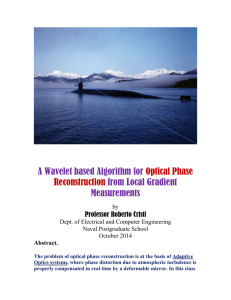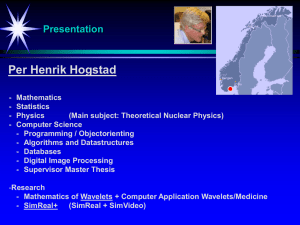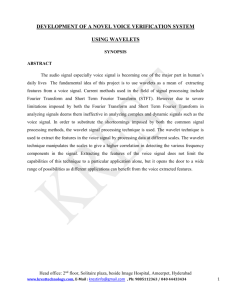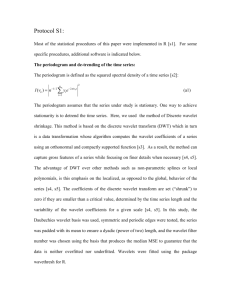B. Mathematical morphological transformation
advertisement
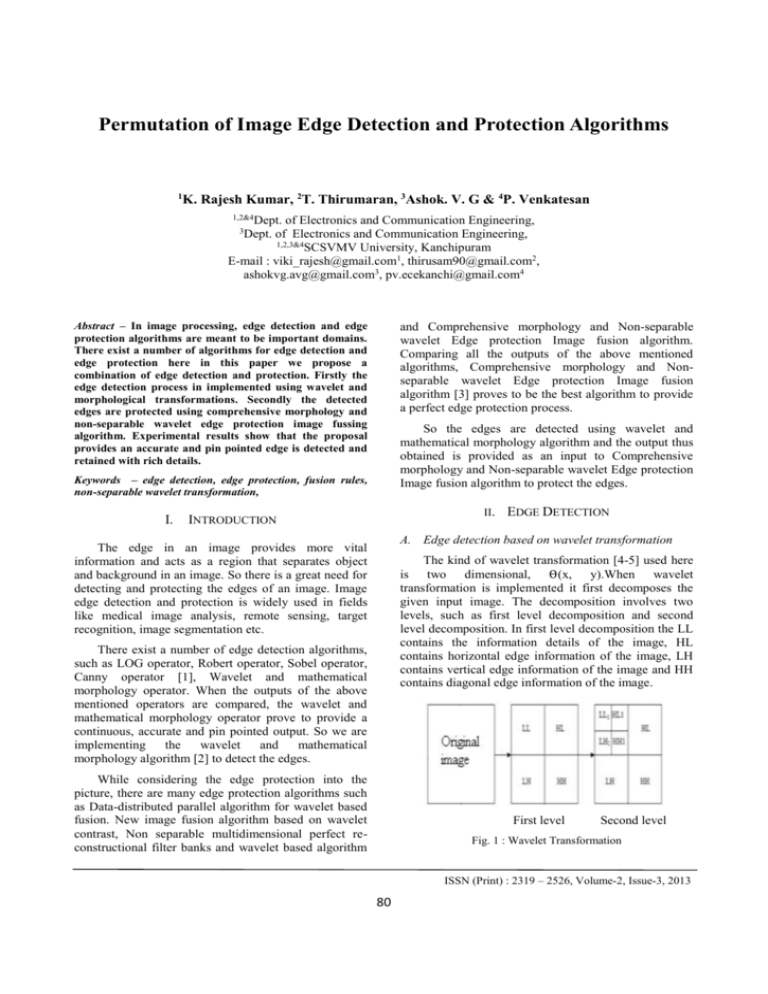
Permutation of Image Edge Detection and Protection Algorithms 1 K. Rajesh Kumar, 2T. Thirumaran, 3Ashok. V. G & 4P. Venkatesan 1,2&4 Dept. of Electronics and Communication Engineering, Dept. of Electronics and Communication Engineering, 1,2,3&4 SCSVMV University, Kanchipuram E-mail : viki_rajesh@gmail.com1, thirusam90@gmail.com2, ashokvg.avg@gmail.com3, pv.ecekanchi@gmail.com4 3 Abstract – In image processing, edge detection and edge protection algorithms are meant to be important domains. There exist a number of algorithms for edge detection and edge protection here in this paper we propose a combination of edge detection and protection. Firstly the edge detection process in implemented using wavelet and morphological transformations. Secondly the detected edges are protected using comprehensive morphology and non-separable wavelet edge protection image fussing algorithm. Experimental results show that the proposal provides an accurate and pin pointed edge is detected and retained with rich details. and Comprehensive morphology and Non-separable wavelet Edge protection Image fusion algorithm. Comparing all the outputs of the above mentioned algorithms, Comprehensive morphology and Nonseparable wavelet Edge protection Image fusion algorithm [3] proves to be the best algorithm to provide a perfect edge protection process. So the edges are detected using wavelet and mathematical morphology algorithm and the output thus obtained is provided as an input to Comprehensive morphology and Non-separable wavelet Edge protection Image fusion algorithm to protect the edges. Keywords – edge detection, edge protection, fusion rules, non-separable wavelet transformation, I. II. INTRODUCTION EDGE DETECTION A. Edge detection based on wavelet transformation The edge in an image provides more vital information and acts as a region that separates object and background in an image. So there is a great need for detecting and protecting the edges of an image. Image edge detection and protection is widely used in fields like medical image analysis, remote sensing, target recognition, image segmentation etc. The kind of wavelet transformation [4-5] used here is two dimensional, ϴ(x, y).When wavelet transformation is implemented it first decomposes the given input image. The decomposition involves two levels, such as first level decomposition and second level decomposition. In first level decomposition the LL contains the information details of the image, HL contains horizontal edge information of the image, LH contains vertical edge information of the image and HH contains diagonal edge information of the image. There exist a number of edge detection algorithms, such as LOG operator, Robert operator, Sobel operator, Canny operator [1], Wavelet and mathematical morphology operator. When the outputs of the above mentioned operators are compared, the wavelet and mathematical morphology operator prove to provide a continuous, accurate and pin pointed output. So we are implementing the wavelet and mathematical morphology algorithm [2] to detect the edges. While considering the edge protection into the picture, there are many edge protection algorithms such as Data-distributed parallel algorithm for wavelet based fusion. New image fusion algorithm based on wavelet contrast, Non separable multidimensional perfect reconstructional filter banks and wavelet based algorithm First level Second level Fig. 1 : Wavelet Transformation ISSN (Print) : 2319 – 2526, Volume-2, Issue-3, 2013 80 International Journal on Advanced Computer Theory and Engineering (IJACTE) Thus the input image i.e. the original image is decomposed into seven sub-images in two levels. The sub image LL1 uses modulus maxima algorithm and all the remaining six sub images uses mathematical morphology. ϴ(x, y) is a Gaussian smoothing function 2. Erosion Operation. This operation is used for the process of merging. 3. For calculating the partial derivative function of the Gaussian Smoothing function, the wavelet function will be Opening Operation. This operation is used to delete the unwanted contents and relatively small objects that exist in the image. 4. Closing operation. This operation is used to fill the small holes that are present in the image. Convolution of f(x, y) will obtain two components of two dimensional wavelet transform in scale s: The expansion and corrosion operations are considered to be dual operations, similarly opening and closing operations are considered to be dual operations. C. Multi-scale and two structuring morphology edge detection If 𝑤 1 f(s, x, y) and 𝑤 2 f(s, x, y) are the two components of wavelet transformation. Smaller structuring element will maintain the edge details in a better way, but it is difficult to eliminate the image noise points. While considering the larger structural element, it can remove the image noise, at the same time it will remove some of the smaller details of the image considering it as a noise. So to compromise the above said issues, we need to use multi-scale and two structuring element for opening and closing operations. Thus the issue is solved by a single structural element. For the scale s, the module of the gradient vector: The angle in scale s is: We can get the edge point of image by detecting the local modulus maxima of wavelet transform coefficients along the gradient vector direction, because The gradient vector direction is the direction of gradient local modulus maxima. Multi scale and two structuring structure elements morphology edge detection operator: Where A and B is respectively diamond shape 5 x 5 structuring element and cross shaped 3 x 3 structuring element, B. Mathematical morphological transformation The theory of mathematical morphology is a tool for analyzing and processing the geometrical structures. Mathematical morphology [6-7] is used to maintain the basic shape and structure of the image data and to remove extraneous structures. The mathematical morphology indulges four basic operations and they are dilation, erosion, opening and closing. 1. Dilation Operation. Because A and B are structuring element with different scale, for the small structure element B, although the ability to remove the noise week, it This operation is used to reduce the object along the boundary. ISSN (Print) : 2319 – 2526, Volume-2, Issue-3, 2013 81 International Journal on Advanced Computer Theory and Engineering (IJACTE) can better maintain the edge information and for large scale structuring element A, it will remove the image noise, but it will lose edge information. So multi scale and two structuring structure element that I proposed not only removes the image noise but can better maintain the edge information. Thus the multi-scale and two structuring element effectively eliminates the noise and maintains good edge information. Let’s assume the gradient of pixel in the image as , gradient of image after down-sampling is , where Z is the integer set. When D performing the down-sampling process on the image: Y( = X(D. Similarly the up-sampling process is: D. Fusion of Wavelet and mathematical morphology. Y( = The wavelet transformation decomposes the image and mathematical morphology based on multi-scale [9] and two structuring element was applied to the high frequency co-efficients of the decomposed sub-images. The consequetive steps are as follows. Where, Y( is the gradient of the image after up- sampling. Since, therefore the signal decomposes D, corresponding two frequency bands, Step1. The first-order partial derivative of Gaussian function was used as the basic wavelet. And the image was decomposed for N times. namely a criterion function and wavelet function , the concrete details are: Step2. For the low-frequency coefficients of the decomposed sub-image, uses modulus maxima for the edge detection Step3. For the high-frequency coefficients of the decomposed sub-image, uses mathematical morphology approach based on multi-scale and two-structuring structure elements for the edge detection. Step4. Use all the coefficients of the above mentioned process to reconstruct the image. Where, pass filter. is the low pass filter, is the high Step5. Smooth the image, eliminate the edge of false information, connect gradually broken edge points, and obtain a single, continuous edge. III. EDGE PROTECTION In edge protection, fusion is commonly used to obtain more edge details. For image fusion algorithm, the kind of wavelet used is separable wavelet, but there are some drawbacks in separable wavelet such as loss in edge information of the fusion image, therefore we prefer non-separable wavelet transformation, which overcome those drawbacks, so designing the reasonable fusion method and matching it to the non-separable wavelet transformation will retain the edges. A. Non-separable wavelet transformation. Here the wavelet filter is based on Quincunx sampling matrix ISSN (Print) : 2319 – 2526, Volume-2, Issue-3, 2013 82 International Journal on Advanced Computer Theory and Engineering (IJACTE) B. Mathematical morphological transformation implement high frequency information fusion rule, in which high frequency components is structured through the fusion method which unifies morphology edge examination’s maximum value and variance weighting analysis. The theory of mathematical morphology [8] is a tool for analyzing and processing the geometrical structures. Mathematical morphology is used to maintain the basic shape and structure of the image data and to remove extraneous structures. The mathematical morphology indulges four basic operations and they are dilation, erosion, opening and closing. 1. Firstly the opening operation is performed for detecting the peripheral part of the wavelet co-efficient. While considering the non-peripheral part variance weighting analysis is used. The variance expression is: Dilation Operation. This operation is used to reduce the object along the boundary. 2. Where Z (i, j) is the non-peripheral point gradation, Erosion Operation. This operation is used for the process of merging. 3. is the mean value of all spot gradation in the fusion image. The non-peripheral, points in the source image is carried on the wavelet co-efficient fusion with the formulae: Opening Operation. This operation is used to delete the unwanted contents and relatively small objects that exist in the image. Where, 4. Closing operation. are the variances of the source image M1 and M2 respectively. This operation is used to fill the small holes that are present in the image. is the wavelet co-efficient of M1 and M2. is the nonperipheral point fusion co-efficient of the source image. C2. Low frequency component fusion. The expansion and corrosion operations are considered to be dual operations, similarly opening and closing operations are considered to be dual operations. Choosing appropriate edge element is important in edge extraction process. When the window size is certain, the only need is to determine each point value in the window [11]. Commonly the size of the window will be 3X3, 5X5 or 7X7, out of which 3X3, has the highest speed and extracts fine edges. The low frequency is the approximate description of the source image. The human eyes are sensitive to low frequency band of image. The low frequency information can restore the image quality at a greater influence. So the low frequency components are designed by local energy weighting method. C. Image fusion rule Where, is the scale co-efficient after fusion, L1 and L2 is the scale co-efficient s of the source image M1 To obtain a high quality fusion image there is a great need to frame the fusion rules [10]. The fusion rule which maintains the image detail characteristics and reduces the fuzzy information is considered to be a best rule, so the best fusion rule is as follows. and M2. and are the weighting factors. IV. EXPERIMENTAL RESULTS & ANALYSIS In the Matlab7.5 experimental environment according to the above proposed methods for image edge detection test, this algorithm is simple and easy to implement. In order to test the effectiveness of the algorithm diamond-type 5*5 structuring element and C1. High frequency component fusion. The high frequency component contains most important characteristics and detailed information of the source image. So in order to obtain a best output, we ISSN (Print) : 2319 – 2526, Volume-2, Issue-3, 2013 83 International Journal on Advanced Computer Theory and Engineering (IJACTE) cross-shaped 3*3 structuring element were selected, and Gaussian function was used as the basic wavelet. Taking into account the speed of calculation and the requirement of accuracy, we made wavelet decomposition for two times, that is N=2. In order to verify the rationality and the validity of the algorithm proposed. Two medical source images are given in Fig. to carry on the image fusion experiment. The size of two Medicine source images which are precisely matching, is 256*256.Here the fusion method based on separable wavelet transformation and the morphology is in separable wavelet transformation region to use the fusion rules proposed. The fusion method based on separable wavelet transformation combines the local model maximum value and the variance weighting analytic method to wavelet coefficient, and the scale coefficient fusion rule is not changed, also uses the local energy weighting method to carry on the fusion. To view from the visual effect of fusion results. Besides the visual comparison, the information entropy and the average gradient are adopted to carry on quantitative analysis for the fusion image quality. Information entropy amount reflects the information content amount in the fusion image, average gradient reflects image clarity. (c) (d) (e) Table: Three Kind of Fusion Algorithm Objective Evaluation Index: Different Fusion Method Source Image(a) Source Image(b) Separable Wavelet Transformation Fusion Method Separable Wavelet Transformation and Morphology Fusion Method Proposed Algorithm Information Entropy 6.524 7.124 Average Gradient 10.546 4.186 7.387 8.9852 8.596 9.425 12.487 15.654 Fig. 1: (a). input CT image,(b).First level wavelet image, (c).Second level wavelet image,(d).Edge detected CT Image,(e). Morphological image for higher band images (a) (b) V. OUTPUT (c) (a) Fig. 2 (a).input MRI image,(b). First level wavelet image, (c).Second level wavelet image (b) ISSN (Print) : 2319 – 2526, Volume-2, Issue-3, 2013 84 International Journal on Advanced Computer Theory and Engineering (IJACTE) VI. CONCLUSION The good localization properties in the wavelet transformation, acts as a good tool for edge detection. The mathematical morphology helps in deriving the structure of an object in an image. The non-separable wavelet transformation has isotropic and good frequency component. So in this paper we combined all the above said algorithms to detect and protect the edges of a given image. The experimental results show the feasibility and effectiveness of the proposed algorithm. Thus we detected and retained the edges, which can be implanted in medical image analysis, target analysis etc. VII. REFERENCES (a) (b) (d) Canny, J. F. (1986). A computation approach to edge detectors. IEEE Transactions on Pattern Analysis and Machine Intelligence, 8, 34–43. [2] XIA Kai-Jan, YAO Yu-feng, CHANG Jin-yi, ZHONG Shan, An Edge detection improved algorithm based on wavelet and morphological transformation, 978-1-4244-55867/10/$26.00©2010 IEEE. [3] Ge Wen, Gao Li Qun, Ge Yanfeng, Comprehensive morphology and non-separable wavelet edge protection image fusion algorithm, 978-1-4244-1734-6/8/$25.00©2008 IEEE. [4] Guo L Z, Zhao J H. Edge Detection Based on Wavelet Transform [J]. Journal of Qingdao University of Technology 2007 28 (2) :78-80 [5] X. Jing, Y. Nong, and Y. Shang, “Image filtering based on mathematical morphology and visual perception principle,” Chinese Journal of Electronics, vol. 13, no. 4, pp. 612–616, April 2004 [6] P. Maragos, “Differential morphology and image processing,” IEEE Trans Image Processing, vol. 5, no. 6, pp. 922–937, June 1996. [7] S. Ghosal, R. Mehrotra , "Detection of composite edge", IEEE Transactions on Image Processing 3(1),1994, pp. 14-25. [8] Liu Q, Lin S S. Edge detection method based on math morphological transforms [J]. Journal of South China University of Technology� 2008�36�9�:113-11 [9] S. Mukhopadhyay and B. Chanda, “ Multiscale morphologicalsegmentation of gray-scale images,” IEEE Transactions on ImageProcessing, vol. 12, no. 5, pp. 533-549, May 2003. (c) (e) Fig. 3 (a). Morphological image for higher band images, (b). Edge detected MRI image,(c).CT image,(d). MRI image, (e). Separable wavelet transformation fusion method (a) [1] (b) . Fig. 4 (a).Separable wavelet,(b).Output image transformation & morphology fusion. ISSN (Print) : 2319 – 2526, Volume-2, Issue-3, 2013 85 International Journal on Advanced Computer Theory and Engineering (IJACTE) [10] R. Chao, K. Zhang, Y.J Lie, An image fusion algorithm using wavelet transformation, Acta Electronical Sinca, Vol. 32, No. 5, 750-753, 2004. [11] S.C Pei, F.C Chen, Hierarchical image representation by mathematical morphology subband decomposition, pattern recognition letters, Vol.16, No.2, 183-192, 1995. ISSN (Print) : 2319 – 2526, Volume-2, Issue-3, 2013 86




